Neanderthal anatomy
Neanderthal anatomy differed from modern humans in that they had a more robust build and distinctive morphological features, especially on the cranium, which gradually accumulated more derived aspects, particularly in certain isolated geographic regions.
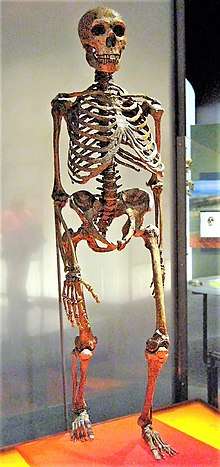
Anatomical evidence suggests they were much stronger than modern humans[1] while they were slightly shorter than the average human, based on 45 long bones from at most 14 males and 7 females, height estimates using different methods yielded averages in the range of 164–168 cm (65–66 in) for males and 152–156 cm (60–61 in) for females.[2] Samples of 26 specimens in 2010 found an average weight of 77.6 kg (171 lb) for males and 66.4 kg (146 lb) for females.[3] A 2007 genetic study suggested some Neanderthals may have had red hair.[4][5]
Distinguishing physical traits
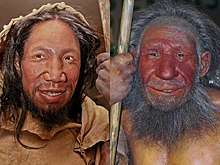
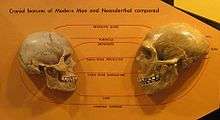
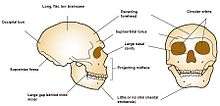
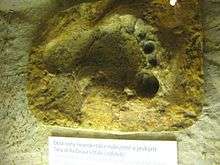


The magnitude of autapomorphic traits in specimens differ in time. In the latest specimens, autapomorphy is unclear.
The following is a list of physical traits that distinguish Neanderthals from modern humans. However, not all of them distinguish specific Neanderthal populations from various geographic areas, evolutionary periods, or other extinct humans. Also, many of these traits are present in modern humans to varying extent due to both archaic admixture and the retention of ancestral hominid traits shared with Neanderthals and other archaic humans. Nothing is certain (from unearthed bones) about the shape of soft parts such as eyes, ears, and lips of Neanderthals.[7]
While the structure of the head and face were not very far removed from those of modern humans, there were still quite noticeable differences. Notably the neanderthal head is much longer, with a more pronounced facial front. The Neanderthal chin and forehead sloped backwards and the nose region protruded forward more than in modern humans. The common shapes of the nose are not known but in general it was likely more robust, and possibly slightly larger, than in modern humans. The brain space of the skull, and so most likely the brain itself, were larger than in modern humans.
When comparing traits to worldwide average present day human traits in Neanderthal specimens, the following traits are distinguished. The magnitude on particular trait changes with 300,000 years timeline. The large number of classic Neanderthal traits is significant because some examples of paleolithic and even modern Homo sapiens may sometimes show one or even a few of these traits, but not most or all of them at the same time.
In October 2018, scientists announced the 3-D virtual reconstruction, for the first time, of a Neanderthal rib cage, which may help researchers better understand how this ancient human species moved and breathed.[8][9]
In February 2019, scientists reported evidence that Neanderthals walked upright much like modern humans.[10][11]
- Cranial
- Sloping forehead
- Suprainiac fossa, a groove above the inion
- Occipital bun, a protuberance of the occipital bone, which looks like a hair knot[12]
- Projecting mid-face (midsagittal prognathism)
- Projecting jaws (maxillary and mandibular prognathism)
- Less neotenized skull than of a majority of modern humans[6]
- Low, elongated skull with flat lambdoid region
- Broad cranial vault with "en bombe" parietal morphology
- A flat basicranium[13][14][15]
- Supraorbital ridge, a prominent, trabecular (spongy) brow ridge
- 1,500–1,740 cm3 (92–106 cu in) cranial capacity (modern human: 1425 cm3)
- Lack of a protruding chin (mental protuberance; although later specimens possess a slight protuberance)
- Crest on the mastoid process behind the ear opening
- No groove on canine teeth
- A retromolar space posterior to the third molar
- Broad nose
- Bony projections on the sides of the nasal opening, projecting nose
- Distinctive shape of the bony labyrinth in the ear
- Larger mental foramen in mandible for facial blood supply
- Sub-cranial
- Considerably more robust, stronger build
- Long clavicles (however, Neanderthal clavicles are not relatively long and are proportionately similar to those of modern humans[16])
- Broad shoulders and pelvis
- Large, wide shoulder blades
- Broad chest
- Barrel-shaped or bell-shaped rib cage and no waist[17] (unclear and debated)
- More laterally curved radius with a radial tuberosity placed more medially, a longer radial neck, a more ovoid radial head, and a well-developed interosseous crest.[18]
- Curved limbs
- On the ulna, the trochlear notch is facing more anteriorly, the brachialis insertion is lower, the mid-shaft is larger, and the shaft is more sinusoidal.[18]
- Thick joints
- Large hands and feet
- Larger round finger tips
- Large kneecaps
- Thick, bowed shaft of the thigh bones, bowed femur
- Short tibiae
- Short fibulae
- Large calcaneus.[19]
- Long, gracile pelvic pubis (superior pubic ramus)
Cold-adapted theory
Some people thought that the large Neanderthal noses were an adaptation to the cold,[20] but primate and arctic animal studies have shown sinus size reduction in areas of extreme cold rather than enlargement in accordance with Allen's rule.[21] Todd C. Rae summarizes explanations about Neanderthal anatomy as trying to find explanations for the "paradox" that their traits are not cold-adapted.[21] Therefore, Rae concludes that the design of the large and extensive Neanderthal nose was evolved for the hotter climate of the Middle East and went unchanged when the Neanderthals entered Europe.[21] However Neanderthals in Spain date back to 700,000 years, prior to them living in the Middle East. Rae supposes that Neandertals, due to increased physical activity and a large amount of muscle mass, would have needed increased oxygen uptake.
Levantine Neanderthals had phenotypes significantly more similar to modern humans than European Neanderthals (classic Neanderthals).[22][23] This may be because of gene flow from early modern humans in the Levantine corridor or the fact that the European Neanderthal phenotype is a specialized climatic adaptation.
Pathology
Within the west Asian and European record, there are five broad groups of pathology or injury noted in Neanderthal skeletons.
Fractures
Neanderthals seemed to suffer a high frequency of fractures, especially common on the ribs (Shanidar IV, La Chapelle-aux-Saints 1 'Old Man'), the femur (La Ferrassie 1), fibulae (La Ferrassie 2 and Tabun 1), spine (Kebara 2) and skull (Shanidar I, Krapina, Sala 1). These fractures are often healed and show little or no sign of infection, suggesting that injured individuals were cared for during times of incapacitation. It has been remarked that Neanderthals showed a frequency of such injuries comparable to that of modern rodeo professionals, showing frequent contact with large, combative mammals. The pattern of fractures, along with the absence of throwing weapons, suggests that they may have hunted by leaping onto their prey and stabbing or even wrestling it to the ground.[24]
Trauma
Particularly related to fractures are cases of trauma seen on many skeletons of Neanderthals. These usually take the form of stab wounds, as seen on Shanidar III, whose lung was probably punctured by a stab wound to the chest between the eighth and ninth ribs. This may have been an intentional attack or merely a hunting accident; either way the man survived for some weeks after his injury before being killed by a rock fall in the Shanidar cave. Other signs of trauma include blows to the head (Shanidar I and IV, Krapina), all of which seemed to have healed, although traces of the scalp wounds are visible on the surface of the skulls.
Degenerative disease
Arthritis was common in the older Neanderthal population, specifically targeting areas of articulation such as the ankle (Shanidar III), spine and hips (La Chapelle-aux-Saints 'Old Man'), arms (La Quina 5, Krapina, Feldhofer) knees, fingers and toes. This is closely related to degenerative joint disease, which can range from normal, use-related degeneration to painful, debilitating restriction of movement and deformity and is seen in varying degree in the Shanidar skeletons (I–IV).
Developmental stress
.jpg)
Two non-specific indicators of stress during development are found in teeth, which record stresses, such as periods of food scarcity or illness, that disrupt normal dental growth. One indicator is enamel hypoplasia, which appears as pits, grooves, or lines in the hard enamel covering of teeth. The other indicator, fluctuating asymmetry, manifests as random departures from symmetry in paired biological structures (such as right and left teeth). Teeth do not grow in size after they form nor do they produce new enamel, so enamel hypoplasia and fluctuating asymmetry provide a permanent record of developmental stresses occurring in infancy and childhood. A study of 669 Neanderthal crowns showed that 75% of individuals suffered some degree of hypoplasia. Two studies,[25][26] compared Neanderthals with the Tigara, coastal whale-hunting people from Point Hope Alaska, finding comparable levels of linear enamel hypoplasia (a specific form of hypoplasia) and higher levels of fluctuating asymmetry in Neanderthals. Estimated stress episode duration from Neanderthal linear enamel hyoplasias suggest that Neandertals experienced stresses lasting from two weeks to up to three months.
Infection
Evidence of infections on Neanderthal skeletons is usually visible in the form of lesions on the bone, which are created by systemic infection on areas closest to the bone. Shanidar I has evidence of the degenerative lesions as does La Ferrassie 1, whose lesions on both femora, tibiae and fibulae are indicative of a systemic infection or carcinoma (malignant tumour/cancer).
Childhood
Neanderthal children may have grown faster than modern human children. Modern humans have the slowest body growth of any mammal during childhood (the period between infancy and puberty) with lack of growth during this period being made up later in an adolescent growth spurt.[27][28][29] The possibility that Neanderthal childhood growth was different was first raised in 1928 by the excavators of the Mousterian rock-shelter of a Neanderthal juvenile.[30] Arthur Keith in 1931 wrote, "Apparently Neanderthal children assumed the appearances of maturity at an earlier age than modern children."[31] The rate of body maturation can be inferred by comparing the maturity of a juvenile's fossil remains and the estimated age of death.
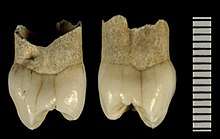
The age at which juveniles can be indirectly inferred from their tooth morphology, development and emergence. This has been argued to both support[32] and question[33][34] the existence of a maturation difference between Neanderthals and modern humans. Since 2007, tooth age can be directly calculated using the noninvasive imaging of growth patterns in tooth enamel by means of x-ray synchrotron microtomography.[35]
This research supports the occurrence of much more rapid physical development in Neanderthals than in modern human children.[36] The x-ray synchrotron microtomography study of early H. sapiens sapiens argues that this difference existed between the two species as far back as 160,000 years before present.[37]
More recent research, published in September 2017 and based on a more complete skeleton of a Neanderthal juvenile (7.7 years old) found in a 49,000 year old site in Northern Spain, indicates that Neanderthal children actually grew at a similar rate to modern humans. Researchers were able to examine dental, cranial, and postcranial material, allowing the assessment of dental and skeletal maturation with age. In fact the main difference between Neandertals and modern humans was reported in the vertebral column. Several features also indicated ongoing brain growth. It was observed that the pattern of vertebral maturation and extended brain growth might reflect the broad Neanderthal body form and physiology, rather than a fundamental difference in the overall pace of growth in Neanderthals compared to modern humans.[38]
Footnotes
- "Neanderthal". BBC. Retrieved 18 May 2009.
- Helmuth H (1998). "Body height, body mass and surface area of the Neanderthals". Zeitschrift für Morphologie und Anthropologie. 82 (1): 1–12. PMID 9850627.
- Froehle, Andrew W; Churchill, Steven E (2009). "Energetic Competition Between Neandertals and Anatomically Modern Humans" (PDF). PaleoAnthropology: 96–116. Retrieved 31 October 2011.
- Laleuza-Fox, Carles; Holger Römpler; et al. (25 October 2007). "A Melanocortin 1 Receptor Allele Suggests Varying Pigmentation Among Neanderthals". Science. 318 (5855): 1453–5. Bibcode:2007Sci...318.1453L. doi:10.1126/science.1147417. PMID 17962522.
- Rincon, Paul (25 October 2007). "Neanderthals 'were flame-haired'". BBC News. Retrieved 25 October 2007.
- Montagu, A. (1989). Growing Young. Bergin & Garvey: CT.
- Sawyer GJ, Maley B (March 2005). "Neanderthal reconstructed". The Anatomical Record Part B: The New Anatomist. 283 (1): 23–31. doi:10.1002/ar.b.20057. PMID 15761833. Lay summary – LiveScience (10 March 2005).
- University of Washington (30 October 2018). "Study reconstructs Neandertal ribcage, offers new clues to ancient human anatomy". Phys.org. Retrieved 31 October 2018.
- Gómez-Olivencia, Asier; et al. (30 October 2018). "3D virtual reconstruction of the Kebara 2 Neandertal thorax". Nature Communications. 9 (4387): 4387. Bibcode:2018NatCo...9.4387G. doi:10.1038/s41467-018-06803-z. PMC 6207772. PMID 30377294.
- Haeusler, Martin; et al. (25 February 2019). "Morphology, pathology, and the vertebral posture of the La Chapelle-aux-Saints Neandertal". Proceedings of the National Academy of Sciences of the United States of America. 116 (11): 4923–4927. doi:10.1073/pnas.1820745116. PMC 6421410. PMID 30804177.
- Cassella, Carly (1 March 2019). "We Have Been Wrong About a Key Feature of Neanderthals' Appearance". ScienceAlert.com. Retrieved 1 March 2019.
- Gunz P, Harvati K (March 2007). "The Neanderthal 'chignon': variation, integration, and homology". Journal of Human Evolution. 52 (3): 262–74. doi:10.1016/j.jhevol.2006.08.010. PMID 17097133.
- "Archived copy". Archived from the original on 8 September 2008. Retrieved 17 July 2010.CS1 maint: archived copy as title (link)
- Bower, Bruce (11 April 1992). "Neanderthals to investigators: can we talk? – vocal abilities in pre-historic humans". Science News. Retrieved 29 April 2014.
- Arensburg B, Schepartz LA, Tillier AM, Vandermeersch B, Rak Y (October 1990). "A reappraisal of the anatomical basis for speech in Middle Palaeolithic hominids". American Journal of Physical Anthropology. 83 (2): 137–46. doi:10.1002/ajpa.1330830202. PMID 2248373.
- Trinkaus, Erik (25 March 2014). "Neandertal clavicle length". Proc Natl Acad Sci U S A. 111 (12): 4438–4442. doi:10.1073/pnas.1402439111. PMC 3970543. PMID 24616525.
- "Scientists Build 'Frankenstein' Neanderthal Skeleton".
- De Groote I (October 2011). "The Neanderthal lower arm". Journal of Human Evolution. 61 (4): 396–410. doi:10.1016/j.jhevol.2011.05.007. PMID 21762953.
- Bower, Bruce (3 February 2011). "Spring-Loaded Heels Gave Extra Step to Early Humans". Wired.
- Finlayson, C (2004). Neanderthals and modern humans: an ecological and evolutionary perspective. Cambridge University Press. pp. 84. ISBN 978-0-521-82087-5.
- Rae TC, Koppe T, Stringer CB (February 2011). "The Neanderthal face is not cold adapted". Journal of Human Evolution. 60 (2): 234–9. doi:10.1016/j.jhevol.2010.10.003. PMID 21183202.
- "Classical vs Levantine Neanderthals SLIDES | Neanderthal | Skull".
- Ayala, Francisco J.; Cela-Conde, Camilo J. (1 March 2017). Processes in Human Evolution: The journey from early hominins to Neanderthals and modern humans. ISBN 9780191060458.
- T.D. Berger & E. Trinkaus (1995). "Patterns of trauma among Neadertals". Journal of Archaeological Science. 22 (6): 841–852. doi:10.1016/0305-4403(95)90013-6.
- Guatelli-Steinberg D, Larsen CS, Hutchinson DL (2004). "Prevalence and the duration of linear enamel hypoplasia: a comparative study of Neandertals and Inuit foragers". Journal of Human Evolution. 47 (1–2): 65–84. doi:10.1016/j.jhevol.2004.05.004. PMID 15288524.
- Barrett CK, Guatelli-Steinberg D, Sciulli PW (October 2012). "Revisiting dental fluctuating asymmetry in neandertals and modern humans". American Journal of Physical Anthropology. 149 (2): 193–204. doi:10.1002/ajpa.22107. PMID 22791408.
- Walker R, Hill K, Burger O, Hurtado AM (April 2006). "Life in the slow lane revisited: ontogenetic separation between chimpanzees and humans". American Journal of Physical Anthropology. 129 (4): 577–83. doi:10.1002/ajpa.20306. PMID 16345067.
- Bogin, Barry (1997). "Evolutionary hypotheses for human childhood". American Journal of Physical Anthropology. 104 (S25): 63–89. doi:10.1002/(SICI)1096-8644(1997)25+<63::AID-AJPA3>3.0.CO;2-8. hdl:2027.42/37682.
- Bogin, Barry (1999). Patterns of human growth. Cambridge: Cambridge University Press. ISBN 978-0-521-56438-0. OCLC 39692257.
- Garrod, D. A. E., Buxton, L. H. D., Elliot-Smith, G., Bate, D.M. A. (1928). "Excavation of a Mousterian rock-shelter at Devil's Tower, Gibraltar". Journal of the Royal Anthropological Institute. 58: 33–113. JSTOR 4619528.CS1 maint: multiple names: authors list (link)
- Keith, Arthur (1931). New discoveries relating to the antiquity of man. London: W. W. Norton & Company. p. 346. OCLC 3665578.
- Ramirez Rozzi FV, Bermudez De Castro JM (April 2004). "Surprisingly rapid growth in Neanderthals". Nature. 428 (6986): 936–9. Bibcode:2004Natur.428..936R. doi:10.1038/nature02428. PMID 15118725.
- Macchiarelli R, Bondioli L, Debénath A, et al. (December 2006). "How Neanderthal molar teeth grew". Nature. 444 (7120): 748–51. Bibcode:2006Natur.444..748M. doi:10.1038/nature05314. PMID 17122777.
- Guatelli-Steinberg D, Reid DJ, Bishop TA, Larsen CS (October 2005). "Anterior tooth growth periods in Neandertals were comparable to those of modern humans". Proceedings of the National Academy of Sciences of the United States of America. 102 (40): 14197–202. Bibcode:2005PNAS..10214197G. doi:10.1073/pnas.0503108102. PMC 1242286. PMID 16183746.
- Tafforeau P, Smith TM (February 2008). "Nondestructive imaging of hominoid dental microstructure using phase contrast X-ray synchrotron microtomography". Journal of Human Evolution. 54 (2): 272–8. doi:10.1016/j.jhevol.2007.09.018. PMID 18045654.
- Smith TM, Toussaint M, Reid DJ, Olejniczak AJ, Hublin JJ (December 2007). "Rapid dental development in a Middle Paleolithic Belgian Neanderthal". Proceedings of the National Academy of Sciences of the United States of America. 104 (51): 20220–5. Bibcode:2007PNAS..10420220S. doi:10.1073/pnas.0707051104. PMC 2154412. PMID 18077342.
- Smith TM, Tafforeau P, Reid DJ, et al. (April 2007). "Earliest evidence of modern human life history in North African early Homo sapiens". Proceedings of the National Academy of Sciences of the United States of America. 104 (15): 6128–33. doi:10.1073/pnas.0700747104. PMC 1828706. PMID 17372199.
- Rosas, Antonio; Ríos, Luis; Estalrrich, Almudena; Liversidge, Helen; García-Tabernero, Antonio; Huguet, Rosa; Cardoso, Hugo; Bastir, Markus; Lalueza-Fox, Carles (22 September 2017). "The growth pattern of Neandertals, reconstructed from a juvenile skeleton from El Sidrón (Spain)" (PDF). Science. 357 (6357): 1282–1287. Bibcode:2017Sci...357.1282R. doi:10.1126/science.aan6463. ISSN 0036-8075. PMID 28935804.
External links
| Wikimedia Commons has media related to Homo neanderthalensis. |
| Wikibooks has a book on the topic of: Introduction to Paleoanthropology |
| Wikispecies has information related to Homo neanderthalensis |
